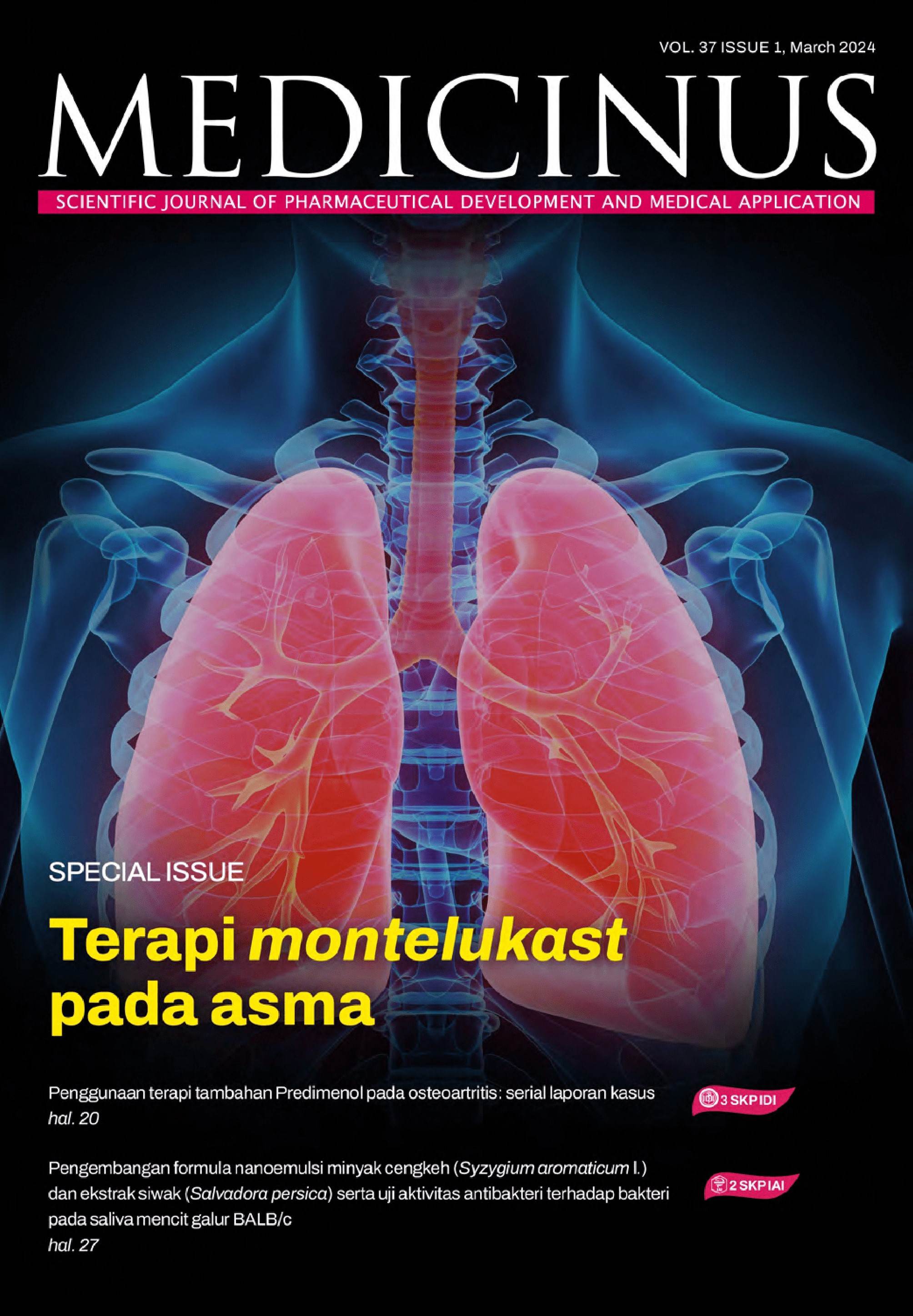Pengembangan Formula Nanoemulsi Minyak Cengkeh (Syzygium aromaticum L.) dan Ekstrak Siwak (Salvadora persica) serta Uji Aktivitasnya terhadap Bakteri dari Saliva Mencit Galur BALB/c
DOI:
https://doi.org/10.56951/jp1ap691Kata Kunci:
mulut, bakteri, ekstrak siwak, minyak cengkeh, nanoemulsiAbstrak
Mulut merupakan habitat bagi sekitar 700 spesies bakteri yang dapat memicu gangguan jika kebersihan mulut tidak terjaga. Salah satu upaya menjaga kebersihan mulut adalah dengan menggunakan mouthwash atau obat kumur. Saat ini masih banyak beredar obat kumur di pasaran yang mengandung alkohol, padahal penggunaan alkohol dalam obat kumur dapat menimbulkan beberapa efek samping setelah pemakaian. Di sisi lain, terdapat bahan alam yang memiliki aktivitas antibakteri terhadap bakteri mulut seperti Salvadora persica dan Syzygium aromaticum. Minyak cengkeh merupakan minyak atsiri yang kurang stabil, sehingga pada penelitian ini dikembangkan formula nanoemulsi minyak cengkeh dengan penambahan ekstrak siwak. Formula akhir nanoemulsi diuji aktivitas antibakterinya terhadap bakteri dari saliva mencit galur BALB/c melalui penentuan konsentrasi hambat minimum (KHM). Pada formula akhir, diperoleh nanoemulsi dengan ukuran 22,4 nm dengan indeks polidispersitas 0,385, zeta potensial -2,1 mV,dan pH 7,15. Hasil uji aktivitas antibakteri menunjukkan bahwa nanoemulsi yang ditambahkan dan tidak ditambahkan ekstrak siwak memiliki KHM terhadap bakteri saliva mencit sebesar 6,25 mg/ml. Hal ini disebabkan karena KHM dari minyak cengkeh adalah 6,25 mg/mL, sedangkan dari ekstrak siwak adalah 12,5 mg/ml sehingga jumlah ekstrak dalam formula tidak dapat menurunkan KHM nanoemulsi. Hasil uji stabilitas menunjukkan bahwa nanoemulsi stabil terhadap 2 siklus beku-cair dan masih dapat diterima pada penyimpanan selama 4 minggu dalam suhu 4°C. Oleh karena itu, dapat dikatakan bahwa formula yang dikembangkan memiliki aktivitas antibakteri terhadap bakteri saliva mencit BALB/c dan memiliki stabilitas yang cukup baik selama 4 minggu dengan suhu penyimpanan 4°C.
Unduhan
Referensi
Lim Y, Totsika M, Morrison M, Punyadeera C. Oral microbiome: A new biomarker reservoir for oral and oropharyngeal cancers. Theranostics 2017;7(17):4313-21. DOI: https://doi.org/10.7150/thno.21804
Bechir F, Pacurar M, Tohati A, Bataga SM. Comparative study of salivary ph, buffer capacity, and flow in patients with and without gastroesophageal reflux disease. Int J Environ Res Public Health. 2022;19(1):201. DOI: https://doi.org/10.3390/ijerph19010201
Li X, Liu Y, Yang X, Li C, Song Z. X. Li, Y. Liu, X. Yang, C. Li, and Z. Song, “The oral microbiota: Community composition, influencing factors, pathogenesis, and interventions. Front. Microbiol. 2022;13:895537. DOI: https://doi.org/10.3389/fmicb.2022.895537
Deo PN, Deshmukh R. Oral microbiome: Unveiling the fundamentals. J Oral Maxillofac Pathol. 2019;23(1):122–8. DOI: https://doi.org/10.4103/jomfp.JOMFP_304_18
World Health Organization. Global oral health status report: Towards universal health coverage for oral health by 2030. World Health Organization. 2022.
Chelli-Chentouf N, Meddah ATT, Mullie C, Aoues A, Meddah B. In vitro and in vivo antimicrobial activity of Algerian Hoggar Salvadora persica L. extracts against microbial strains from children’s oral cavity. J Ethnopharmacol. 2012;144(1):57-66. DOI: https://doi.org/10.1016/j.jep.2012.08.025
Gupta V, Pant VA, Pandey S, Pant AB. Efficacy and safety evaluation of alcohol-containing and alcohol-free mouth rinses: A clinicocytological study. Journal of Indian Society of Periodontology 25(2):128-32. DOI: https://doi.org/10.4103/jisp.jisp_196_20
Halawany HS. A review on miswak (Salvadora persica) and its effect on various aspects of oral health. Saudi Dent J. 2012;24(2):63–9. DOI: https://doi.org/10.1016/j.sdentj.2011.12.004
Hesham AE, Alrumman SA. Antibacterial activity of Miswak (Salvadora persica) extracts against isolated and genetically identified oral cavity pathogens. Technol Health Care. 2016:24(2):S841-8. DOI: https://doi.org/10.3233/THC-161214
Jiang H, Zhong S, Schwarz P, Chen B. Chemical composition of essential oils from leaf and bud of clove and their impact on the antifungal and mycotoxin inhibitory activities of clove oil-in-water nanoemulsions. Industrial Crops and Products 2022;187:115479. DOI: https://doi.org/10.1016/j.indcrop.2022.115479
Parham S, Kharazi AZ, Bakhsheshi-Rad HR, Nur H, Ismail AF, Sharif S, et al. Antioxidant, antimicrobial and antiviral properties of herbal materials. Antioxidants (Basel). 2020; 9(12):1309. DOI: https://doi.org/10.3390/antiox9121309
Galvao LCC, Furletti VF, Bersan SMF, da Cunha MG, Ruiz ALTG, de Carvalho JE, et al. Antimicrobial activity of essential oils against Streptococcus mutans and their antiproliferative effects. Evid Based Complement Alternat Med. 2012:2012:751435. DOI: https://doi.org/10.1155/2012/751435
Rodrigue L, Marion D, Trudel L, Barthe C, Lavoie MC. Comparison of methods for the evaluation of the oral microbiota of mice. Journal of Microbiological Methods 1989;10(2):71-82. DOI: https://doi.org/10.1016/0167-7012(89)90003-1
Farnsworth NR. Biological and phytochemical screening of plants. J Pharm Sci. 1966;55(3):225-76. DOI: https://doi.org/10.1002/jps.2600550302
Syukri Y, Kholidah Z, and Chabib L. Fabrikasi dan Studi Stabilitas Self-Nano Emulsifying Propolis menggunakan Minyak Kesturi sebagai Pembawa. Jurnal Sains Farmasi & Klinis 2020;6(3):265-73. DOI: https://doi.org/10.25077/jsfk.6.3.265-273.2019
Reiner K. Catalase test protocol. Available at https://asm.org/getattachment/72a871fc-ba92-4128-a194-6f1bab5c3ab7/Catalase-Test-Protocol.pdf
Leber AL. Biochemical tests for the identification of aerobic bacteria. In: Clinical Microbiology Procedures Handbook. 2016; Chapter 3.17. 4th Edition. Volume 1-3. doi:10.1128/9781555818814.ch3.17.1. DOI: https://doi.org/10.1128/9781555818814.ch3.17
CLSI. Methods for Dilution Antimicrobial Susceptibility Tests for Bacteria That Grow Aerobically; Approved Standard—Ninth Edition. 2012.
Ullah N, Amin A, Alamoudi RA, Rasheed SA, Alamoudi RA, Nawaz A, et al. Fabrication and optimization of essential-oil-loaded nanoemulsion using box-behnken design against Staphylococos aureus and Staphylococos epidermidis Isolated from oral cavity. Pharmaceutics. 2022;14(8):1640. DOI: https://doi.org/10.3390/pharmaceutics14081640
Campelo MDS, Melo EO, Arrais SP, Nascimento FBSAD, Gramosa NV, Soares SDA, et al. Clove essential oil encapsulated on nanocarrier based on polysaccharide: A strategy for the treatment of vaginal candidiasis. Colloids and Surfaces A: Physicochemical and Engineering Aspects 2021;610:125732. DOI: https://doi.org/10.1016/j.colsurfa.2020.125732
Sneha K, Ashwani K. Nanoemulsions: Techniques for the preparation and the recent advances in their food applications. Innovative Food Science & Emerging Technologies 2022;76:102914. DOI: https://doi.org/10.1016/j.ifset.2021.102914
Ding Z, Jiang Y, Liu X. Chapter 12 - Nanoemulsions-Based Drug Delivery for Brain Tumors. Nanotechnology-Based Targeted Drug Delivery Systems for Brain Tumors 2018:327-58. DOI: https://doi.org/10.1016/B978-0-12-812218-1.00012-9
Suciati T, Aliyandi A, Satrialdi. Development of transdermal nanoemulsion formulation for simultaneous delivery of protein vaccine and artin-m adjuvant. International Journal of Pharmacy and Pharmaceutical Sciences 2014;6(6):536-46.
Xiaowei L, Jean-Charles R, Suyuan Y. Effect of Temperature on Graphite Oxidation Behavior. Nuclear Engineering and Design 2004;227(3):273-80. DOI: https://doi.org/10.1016/j.nucengdes.2003.11.004
Unduhan
Terbitan
Bagian
Diterbitkan
Unduhan
Lisensi
Hak Cipta (c) 2024 Siti Fatimah Zahro, Safira Prisya Dewi, Amirah Adlia, Heni Rachmawati

Artikel ini berlisensi Creative Commons Attribution-NonCommercial 4.0 International License.




